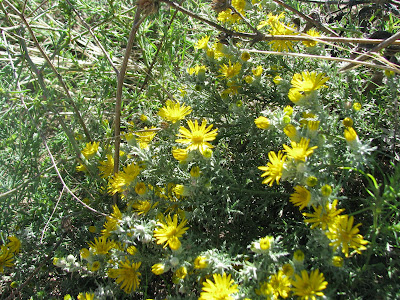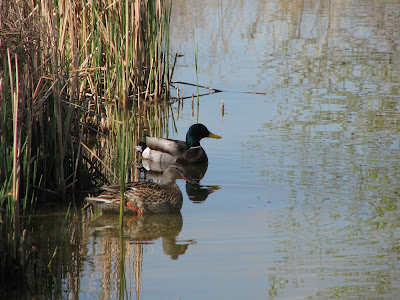Devil's Backbone
We visited Devil's Backbone for the second time on Wednesday this week. It was an absolutely gorgeous day to be outdoors! Devil's Backbone is located in the foothills west of Loveland, just north of Hwy 34. It is the southern access point to an extended trail system that extends north, running along the hogbacks that run between Loveland and Fort Collins.
The trail can be shared by hikers, mountain bikes and horses. The trail initially goes to an outlook point, where you can look into the next valley and see the entire front range. It is an easy trail, with a gradual incline, and it is about 1.6 miles roundtrip from the parking lot. You could easily continue to hike northward, and do the whole circuit - about 5 miles or so? This picture above shows the strata quite well. The hogbacks are made up of sandstone, upheaved eons ago. It is very easy to study the strata on this hike.
Here we are at the lookout. There is a nice sign to name off the peaks in the distance. Long's Peak is to the left of Jordan's head. The mouth of the Big Thompson Canyon is above my head, behind that distant ridge. The flooding that happened from the rains two weeks ago has caused widespread damage all along the river basin. You can't see it from this vantage point, but just a quarter mile to our south is where the Big Thompson river runs south of Hwy 34, and the flood has most certainly left it's mark. After our hike we drove a short ways until we reached the road closure, and were just amazed and saddened at the destruction we saw. Mud and debris everywhere... Shortly after a group of hikers took this picture of me and the kids, another lady arrived and chatted with us a bit. She was from Baton Rouge, LA, and was here volunteering at the Loveland shelter with the Red Cross. She was enjoying a day off and seeing the sights.
Since this was technically a girl scout hike (even though Rylan was the only scout in attendance), I covered with her some more backcountry advice and worked on naming plants with her. We saw several Lacy Tansyasters (above) along the trail, which can be easily identified by their trademark daisy-like petal formation and delicate, lacy, sage-green foliage and round bushy habit. We also identified yucca, pear cactus, sage, cottonwood, chokecherry, golden currant and yellow rabbitbrush (below).
I didn't get any pictures, but we also watched two bald eagles circling, as well as a red-tailed hawk and a kestrel. The only other creatures we saw were beetles and pesky grasshoppers - including a monster-sized one that was four inches long!
The biggest win for this hike was the fact that both Owen and Colin made it the whole way. Usually Colin requests to be carried, but here he is, almost near the end of the hike, still going strong! Owen was fueled by something else - he really, really, really needed to go potty. ;)












































